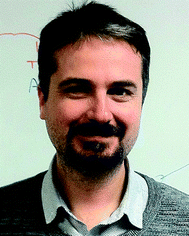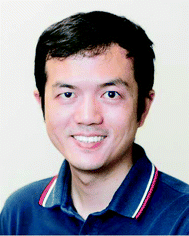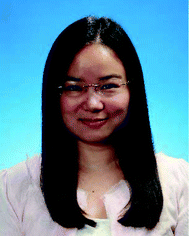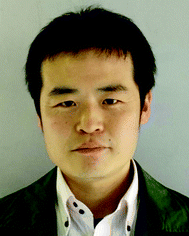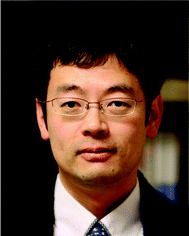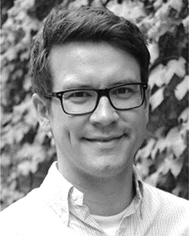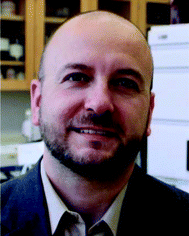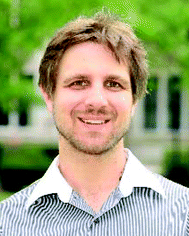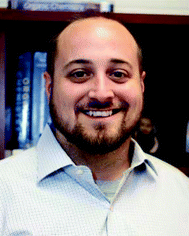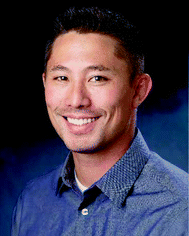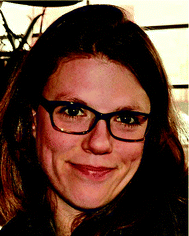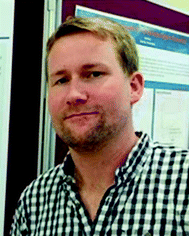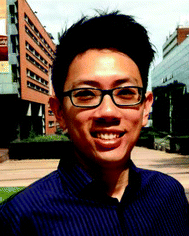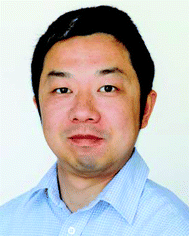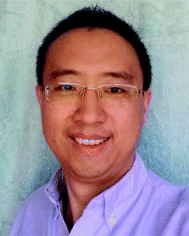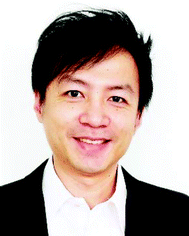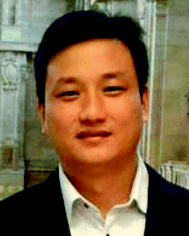DOI:
10.1039/C8PY90042F
(Editorial)
Polym. Chem., 2018,
9, 1469-1478
Emerging Investigators 2018
I vividly recall the warnings I was given before getting into polymer chemistry for my master's thesis research project: the research field was dated, without innovation and largely driven by a slow moving commodities industry that viewed it as a cash cow. Against this backdrop of warnings I started a research career in radical polymerization – in hindsight a serendipitous choice, as the last 20 years have impressively demonstrated. The current collation of research articles from a stellar cast of emerging polymer chemists shows that, even 20 years after the field was revolutionized by the advent of reversible deactivation radical polymerization (RDRP) techniques, creative ideas and innovative chemistries abound. We are fortunate to collate a cross-section of articles in the current special issue, which were based on suggestions from our editorial and advisory board members.
The issue fuses a vibrant mixture of review and research articles spanning the best that contemporary polymer chemistry has to offer. It kicks off with a comprehensive review by James Blinco's team, who not only review the current state-of-the-art nitroxide functional polymers and their applications, but also project their potential in future devices (DOI: 10.1039/C7PY02001E). Colin Bonduelle in his review explores the critical role that polypeptides can play when fused into synthetic polymer hybrid structures (DOI: 10.1039/C7PY01725A).
In the realm of RDRP methodology, Paul Wilson and coworkers exploit SET-LRP to produce well-defined arsenicals in aqueous environments, showcasing the power of SET-LRP processes (DOI: 10.1039/C7PY01852E). Flying the flag for RAFT chemistry is the Konkolewicz laboratory, who introduce an efficient method for generating amine-containing polymers exploiting photolabile protecting groups (DOI: 10.1039/C7PY01398A). Classically, amine polymers are notoriously challenging to control with RAFT techniques. Fusing their trademark spontaneous zwitterionic polymerization techniques with RAFT polymerization allows Kempe and his team to prepare hetero-grafted block copolymers that can be assembled into nanoaggregates (DOI: 10.1039/C7PY01912B). Polymerization-Induced Self-Assembly (PISA) has taken the polymer world by storm. The team of Johannes Brendel teaches us how a nanocarrier system that can respond to oxidative cues can be constructed by fusing PISA with RAFT technology (DOI: 10.1039/C7PY01859B). Edgar Wong, in collaboration with Cyrille Boyer, demonstrates that the fine control of polymer structure and chain length made possible by modern radical polymerization techniques has a critical impact on the capacity of these macromolecules to function as antimicrobial systems (DOI: 10.1039/C7PY01069A). While classical RDRP protocols have amply demonstrated their power, alternative protocols can achieve similarly impressive results. Fang and his team, for example, showcase how conjugated ladder polymers can be prepared using ring closing olefin metathesis – a feat out of reach for radical-based processes (DOI: 10.1039/C7PY02059G). The realm of degradable polymer systems, here poly(conjugated esters), is explored by Kohsaka and his team, using dynamic covalent chemistry to generate a functional library of such polymers by conjugate substitution (DOI: 10.1039/C7PY02114C). The polymerization of novel monomer systems can be highly challenging, and we include an example where Rupar and colleagues exploit anionic ring opening polymerization to prepare unusual poly(azetidines) (DOI: 10.1039/C8PY00074C). If you are interested in how to prepare polymers from sugars and carbondisulfide for ring opening polymerization, the team of Antoine Buchard has developed a great approach (DOI: 10.1039/C8PY00119G).
The design of self-assembly systems continues to be a hot topic for emerging investigators, which comes as no surprise given their vast potential and – arguably – not-yet-fulfilled potential. Bernhard Schmidt's laboratory demonstrates how dual responsive polymer vesicles are designed and shows them to be responsive to both redox as well as pH cues (DOI: 10.1039/C7PY01214D). Schmidt's lab features again in our issue as a double-act with colleagues Luke Connal and Daniel Klinger in a fascinating report on how to impart chemical ordering into nanostructured phase-separated colloidal nanoparticles (DOI: 10.1039/C7PY01817G). Imparting order into nanoparticles is an enduring theme that is investigated on a micellar-level by the Gröschel laboratory, which shows that ABC block copolymers can be organized into patchy micelles (DOI: 10.1039/C7PY01832K). A different approach to nanoobject design is taken by Markus Muellner, who grafts a polymer onto cellulose nanocrystals, which are later removed to afford hollow nanorods (DOI: 10.1039/C7PY01814B). Polymer Chemistry Associate Editor Emily Pentzer makes a different use of nanomaterials, by teaching us how 2D nanosheets can be used as a surfactant for oil-in-oil miniemulsions for the facile design of hollow capsules and functional nanoparticles (DOI: 10.1039/C7PY01819C).
A significant theme in polymer chemistry over the last few years has been the renaissance of light-driven processes that allow unprecedented polymerization control and opportunities in surface design and 3D printing. In an innovative example of light-driven chemistry, Long and colleagues explore how visible light can be used to adjust the microstructure of polyethylenes (DOI: 10.1039/C7PY01836C). The Miyake laboratory also exploits visible light to construct well-defined star polymers using organocatalyzed ATRP (DOI: 10.1039/C7PY01833A). A team effort from Boyer and Xu demonstrates that photocatalysts can be tethered to solid substrates, showing an avenue for the simple recovery of the catalyst of photoinduced RAFT polymerization (DOI: 10.1039/C7PY01690E).
Multi-component reactions have also seen a renaissance in polymer chemistry and are being explored in emerging investigators’ laboratories. Specifically, Rongrong Hu's team uses ambient temperature multi-component reactions to generate functional poly(N-acylsulfonamide)s (DOI: 10.1039/C7PY01983A).
Strongly related to light-driven chemistry are 3D printing processes, with some estimates suggesting that 10% of all consumer materials will be 3D printed by 2030. Pu Xiao explores in a mini-review how the latest technology in photopolymers, monomers and initiators makes the 3D printing revolution happen (DOI: 10.1039/C8PY00157J), while Luke Connal innovates in 3D printing of self-healing cyrogels, demonstrating how their mechanical properties can be readily adjusted (DOI: 10.1039/C7PY01945A). Within the materials area, we have also selected a contribution from the Yen laboratory, who show how polyimidothioethers can be used to prepare electrochromic materials and fluoresecent electrospun materials and shape them in 3D (DOI: 10.1039/C7PY01858D).
In soft matter materials design, the synthesis of networks and their careful characterization continues to be of critical importance. Questions of how we can control the network properties by placing specific functionalities at exact positions in the (monodisperse) polymer strands and, importantly, quantify the number of linkage points within a network are, to-date, not fully answered. In the current issue, the Ikai laboratory elegantly shows how a hydrogen-bonded network can stabilize a helical polymer (DOI: 10.1039/C7PY01867C). Focusing on intermolecular networks, Ida and colleagues explore the influence that the monomer and crosslinker sequence has on the thermoresponsive network properties (DOI: 10.1039/C7PY01793F). In the realm of thermoset preparation, the team of Christian Müller illustrates how a Ti-based catalyst can be used for by-product-free rapid network curing of polyethylenes (DOI: 10.1039/C7PY01840A).
The term ‘precision polymers’ describes macromolecules that have a similar level of definition as their naturally occurring counterparts. In the last 10 years, a wide array of approaches to precision polymers – featuring different levels of control – has been described, yet these systems are still not fully able to emulate nature's complexity. Clearly, the topic is of great interest to emerging investigators too, and we include a contribution from the Kennemur group who demonstrate that the tacticity of polymers prepared by ring-opening polymerization can be finely controlled (DOI: 10.1039/C7PY01922J). An approach to sequence-controlled gradient polymers is described by Zhang and colleagues, demonstrating that simple reaction sequences can lead to complex architectures (DOI: 10.1039/C7PY02125A).
Finally, we decided to pick up on a trend that currently emerges in polymer chemistry: the use of flow chemistry for both thermally as well as photochemical induced reactions. Leibfarth and team introduce a simple flow set-up to determine copolymerization reactivity ratios, not without noting that the method is so simple that several reactivity ratios can be determined in one afternoon (DOI: 10.1039/C7PY01938F). No matter what our views are on the impact of the varied fields that constitute polymer chemistry, I am sure that we can all agree that streamlining experimental designs to save time is an innovation in itself.
I note that the representation of female emerging group leaders in this issue is lower than we had hoped, with male scientists proving four times more likely to accept our invitation to contribute. This is an issue we would like to understand and address, and we will be working hard to do so for future initiatives. I hope you will enjoy our glimpse into the laboratories of emerging investigators as much as we did at Polymer Chemistry.
Christopher Barner–Kowollik, Editor-in-Chief
Biographies of contributors
James Blinco graduated from Queensland University of Technology, Australia, in 2009 with a PhD in chemistry. He took up a postdoctoral position working on polymer synthesis for next generation photoresists at the Centre for Advanced Imaging (CAI) and the Australian Institute for Bioengineering and Nanotechnology (AIBN) at the University of Queensland. In 2010, he was awarded an Alexander von Humboldt research fellowship to work at the Karlsruhe Institute of Technology, Germany, with Prof. Christopher Barner–Kowollik. He is currently employed as a Senior Lecturer at Queensland University of Technology. His research interests include polymer synthesis, free radical- and photo-chemistry.
Colin Bonduelle obtained his PhD in 2009, working on polyester preparation from
O-carboxyanhydrides under the supervision of Dr Didier Bourrissou at the University of Toulouse, France. He then moved for two years to the University of Western Ontario (Canada) and studied block copolymer patterning in relation to surface science, under the supervision of Dr Elizabeth Gillies. Later, he went back to France to work with Prof. Sébastien Lecommandoux at the University of Bordeaux on the topic of amphiphilic copolymer self-assembly. He was appointed as a CNRS research scientist in 2014 at the Laboratoire de Chimie de Coordination in Toulouse. Colin's research interests include polymer synthesis through
N-carboxyanhydride ring-opening polymerization and the use of coordination chemistry as a chemical leverage to tune synthetic polypeptide properties.
Johannes C. Brendel studied chemistry at the University of Bayreuth (Germany) and obtained his diploma in 2009. For his PhD, he joined the group of Mukundan Thelakkat and worked on the synthesis and application of amphiphilic conductive polymers, including a research stay at the group of Prof. Thomas P. Russell at the University of Massachusetts, Amherst. After finishing in 2013, he was awarded a research fellowship of the German Research Foundation (DFG) for a postdoctoral project on the self-assembly of cyclic peptide polymer conjugates at the University of Warwick and the Monash Institute of Pharmaceutical Sciences (MIPS) in Melbourne within the group of Prof. Sébastien Perrier. In 2016, he joined the Jena Center for Soft Matter (JCSM) at the Friedrich-Schiller-University Jena, where he later was appointed as an independent research group leader within the Emmy-Noether Programme of the German Research Foundation (DFG) in 2017. His research interests comprise controlled radical polymerization techniques, such as RAFT polymerizations, well-defined polymer architectures, hierarchical self-assembly into anisotropic nanostructures, and, in particular, supramolecular polymer brushes, with a main focus on their application in biomedicine.
Antoine Buchard is a Royal Society University Research Fellow in the Centre for Sustainable Chemical Technologies (CSCT) at the University of Bath, researching novel chemical transformations and the use in catalysis of renewable resources for the synthesis of sustainable polymers. Originally from France, Antoine obtained his PhD from the Ecole Polytechnique in 2009, investigating iminophosphorane metal complexes for homogeneous catalysis, under the supervision of Professor Pascal Le Floch. He then moved to the UK and worked at Imperial College, London, as a postdoctoral research assistant in the group of Professor Charlotte K. Williams, in the area of CO
2/epoxide copolymers and poly(lactic acid). Antoine returned to France in 2011 and gained industrial R&D experience, working for Air Liquide on Carbon Capture, Storage and Utilisation (CCSU) projects. In April 2013, Antoine began his independent research career at the CSCT as a Whorrod Research Fellow. In October 2017, Antoine was awarded a Royal Society University Research Fellowship. His main research interest deals with the design of new monomers and new polymerisation catalysts for the development of renewable polymers and their applications as sustainable materials.
Luke Connal received a bachelor's of Chemical Engineering and a PhD in polymer chemistry, both from the University of Melbourne. In 2009 he was a joint Sir Keith Murdoch Postdoctoral Fellow and Australian Linkage International Fellow at the University of California, Santa Barbara with Prof. Craig Hawker. In 2013 Luke started his independent career at the University of Melbourne as a Senior Lecturer in the Department of Chemical and Biomolecular Engineering. In 2017 he moved his group to the Research School of Chemistry at the Australian National University. His research interests lie in the development of bioinspired materials using advanced polymer design, self-assembly, catalysis and 3D printing. The materials find use in applications from self-healing coatings and detergents to anti-chemical warfare agents.
Lei Fang obtained his BS (2003) and MS (2006) degrees from Wuhan University in China. He then moved to the US, starting his graduate study at the University of California, Los Angeles and receiving his PhD (2010) from Northwestern University, mentored by Professor Sir Fraser Stoddart. Subsequently, Lei spent 2.5 years at Stanford University as a postdoctoral scholar in Professor Zhenan Bao's group. In 2013, he joined Texas A&M University as an assistant professor of chemistry. Currently Lei's research group focuses on the synthesis, processing, and application of functional conjugated organic materials.
André Gröschel studied chemistry at the University of Bayreuth and graduated in 2012 after working with Axel H. E. Müller on block copolymer synthesis and hierarchical self-assembly of multicompartment nanostructures. From 01/2013–12/2015 he was a member of the group of Olli Ikkala at the Department of Applied Physics of Aalto University School of Science in Helsinki (Finland), pursuing his postdoc research on biomimetic nanocomposites and photonic materials. In January 2016, he received an endowed Evonik-Professorship and moved to the University of Duisburg-Essen (Germany), where he is now a group leader in the Department of Physical Chemistry. In 2017, he was awarded an Emmy Noether Independent Research Group from the German Research Foundation. The group currently consists of 9 graduate students located at the Nano Energy Technic Center in Duisburg. He has published over 30 papers and 2 book chapters. He is a member of the German Chemical Society, the German Colloid Society and the Centre for Nanointegration, and is currently a Guest Editor for a Special Issue of
Polymer. His research interests comprise block copolymer synthesis, self-assembly, electron tomography, liquid cell TEM, block copolymer microparticles, mesoporous carbon, inverse micelles, photonics and energy conversion.
Rongrong Hu received her B.S. degree from Peking University in 2007 and PhD degree from the Hong Kong University of Science and Technology (HKUST) in 2011. She then worked as a research associate at HKUST from 2012–2014. After that, she joined the State Key Laboratory of Luminescent Materials and Devices in South China University of Technology as an associate professor in 2014 and was promoted to professor in 2016. Her research interests lie in the development of alkyne-based multicomponent polymerizations, the design and synthesis of new luminescent materials, and the exploration of functional polymer materials. She has currently published more than 100 SCI papers, which have been cited by others about 3000 times.
Shohei Ida is an Assistant Professor at the Department of Materials Science, The University of Shiga Prefecture. He received his PhD degree in 2011, working on sequence-regulated polymerization under the direction of Prof. Mitsuo Sawamoto at Kyoto University. During his doctoral course, he also studied the synthesis of functional polymers by RAFT polymerization at Universität Bayreuth (Prof. Axel H. E. Müller’s group) as a visiting student selected by the Global-COE Program of Kyoto University in 2009. In 2011, he moved to the University of Shiga Prefecture as an Assistant Professor working with Prof. Yoshitsugu Hirokawa and Prof. Shokyoku Kanaoka. His research interests focus on the structural regulation of polymer gels by utilizing controlled polymerization techniques and monomer sequence regulation for the development of advanced stimuli-responsive materials.
Tomoyuki Ikai was born in Aichi, Japan, in 1980. He received his bachelor’s (2003), master’s (2005) and doctorate (2008) degrees from the Department of Applied Chemistry, Nagoya University, under the supervision of Professors Yoshio Okamoto and Masami Kamigaito. In 2005, he spent 7 weeks at the University of Tübingen with Professor Volker Schurig as an exchange student. In 2008, he joined the group of Professor Yoshio Okamoto in the EcoTopia Science Institute, Nagoya University, as an Assistant Professor. After spending five months at Massachusetts Institute of Technology with Prof. Timothy M. Swager as a Visiting Assistant Professor, he moved to the Graduate School of Natural Science and Technology, Kanazawa University, in 2009 and was promoted to Associate Professor in 2014. He joined the group of Timothy M. Swager again as a Visiting Associate Professor for one year (2016–2017). His research interests include the development of novel functional materials using natural resources and the synthesis of chiral molecules and polymers with unique functions.
Kristian Kempe studied chemistry at the Friedrich-Schiller-University Jena (Germany) and the Eindhoven University of Technology (The Netherlands). In 2010 he was a visiting researcher in the group of Prof. Craig J. Hawker (University of California, Santa Barbara) before he completed his PhD at the end of 2011 under the supervision of Prof. Ulrich S. Schubert in Jena. In 2012 he received a prestigious Alexander von Humboldt-fellowship to conduct research in the groups of Prof. Frank Caruso (University of Melbourne) and Prof. Thomas P. Davis/Prof. David M. Haddleton (Monash University). In mid-2014 Kristian was appointed to the position of Senior Research Fellow at the University of Warwick to work alongside Prof. Haddleton. Currently, he is a group leader and NHMRC-ARC Dementia Research Fellow at the Monash Institute of Pharmaceutical Sciences. His research interests include ‘smart’ responsive macromolecules, biocompatible and biodegradable polymers, poly(2-oxazoline)s, efficient polymer modification reactions, polymer–peptide conjugation strategies, and the design of functional particle systems and hydrogels for applications in nanomedicine and materials science, with a particular focus on brain drug delivery.
Justin G. Kennemur was raised in Yorktown, VA (USA) and received his Bachelor of Science degree in chemistry from Radford University in 2002. After a few years working in industry at Polymer Solutions Incorporated in Blacksburg, VA, he attended graduate school in the Department of Chemistry at North Carolina State University in 2005. He received his PhD in polymer chemistry under the tutelage of Bruce M. Novak in 2010 and soon after started a post-doctoral appointment co-advised by Marc A. Hillmyer and Frank S. Bates at the University of Minnesota. He began his appointment as an Assistant Professor in the Department of Chemistry and Biochemistry at Florida State University in the Fall of 2014. Notable achievements include the North Carolina ACS Richard D. Gilbert Award in Polymer Science (2010), The ACS POLY/PMSE AkzoNobel Student Award (2010), and the FSU First Year Assistant Professor Summer Award (2015). His research interests revolve around a continued fascination with autonomous self-assembly of macromolecular systems and leveraging organic chemistry to afford complex yet precise macromolecules containing dynamic functionality and varying degrees of stereochemistry.
Daniel Klinger is a junior professor at Freie Universität Berlin (FUB) where he is developing new synthetic strategies for functional polymeric nanomaterials. Daniel obtained his PhD at the Max Planck Institute for Polymer Research in Mainz, Germany, where he focused on the development of responsive microgels and polymeric nanoparticles for enzymatic and light-triggered release applications. He then joined the University of California in Santa Barbara (UCSB) as a postdoctoral researcher and started working on surfactant-directed block copolymer self-assembly in nanoparticles. At his subsequent position as a research scientist in the Materials Research Laboratory at UCSB, he combined the area of block copolymer self-assembly with his existing experience in the fields of stimuli-responsive materials and colloidal chemistry. In the department of Biology, Chemistry, and Pharmacy at FUB, he is currently bringing together concepts and methods from polymer synthesis, colloidal chemistry, self-assembly, and the physics of interfaces to a multidisciplinary research concept. This enables the development of functional nanomaterials through hierarchical approaches that span from molecular design, synthesis, and characterization to the final application.
Yasuhiro Kohsaka was born in Tokyo in 1984. In 2005, he graduated from Tokyo Institute of Technology, skipping the 4th grade. He started his academic career as a JSPS Research Fellowship for Young Scientists (DC-1) in 2008. He was further educated as a visiting student at Massachusetts Institute of Technology under the guidance of Prof. Timothy M. Swager in 2010. He received his PhD degree in 2011 from Tokyo Institute of Technology under the supervision of Prof. Toshikazu Takata in the field of supramolecular polymer chemistry. In the same year he moved to become an Assistant Professor at Osaka University. There he changed his research area to precise polymerization chemistry, particularly the synthesis of stereoregular endfunctional polymers, with Prof. Tatsuki Kitayama. In 2011, he became a principle investigator at Shinshu University and set up an independent group as a Tenure-Track Assistant Professor. He received the 5th CERI excellent paper award in 2009 and the 55th Academic Award of Ube Industries Research Foundation in 2015. His current research area is the design and polymerization of new vinyl and cyclic monomers with densely functionalized skeletons.
Dominik Konkolewicz earned his Bachelor’s degree with honours in 2006, from the University of Sydney. In 2011, he earned his PhD from the same institution, advised by Prof. Sébastien Perrier, focusing on the synthesis and characterization of hyperbranched polymers made by RAFT polymerisation. Subsequently, he was a Visiting Assistant Professor/Senior Research Chemist at Carnegie Mellon University from 2011–2014, advised by Prof. Krzysztof Matyjaszewski, where he studied various synthetic and mechanistic aspects of ATRP. In August 2014, he joined Miami University in Oxford, OH, as an Assistant Professor of Organic Chemistry. His research group consists of both graduate and undergraduate researchers working in the fields of organic chemistry, polymer chemistry, materials science and biohybrid materials. Specific areas of interest in his team are: polymerization mechanisms and kinetics, efficient photochemical polymerization and functionalization methods, polymer materials with both supramolecular and dynamic covalent bonds as crosslinkers, and polymer–protein bioconjugates as tuneable biocatalysts.
Frank A. Leibfarth is an Assistant Professor in the Department of Chemistry at the University of North Carolina at Chapel Hill. He completed his B.A. in both chemistry and physics at the University of South Dakota in 2008. Frank conducted his graduate studies at the University of California, Santa Barbara under the direction of Professor Craig J. Hawker on the use of the ketene functional group in polymer chemistry. Upon the completion of his PhD in 2013, he accepted an NSF postdoctoral fellowship to work under the direction of Professor Timothy F. Jamison at the Massachusetts Institute of Technology on the continuous flow synthesis of sequence-defined copolymers. Frank began his independent career in 2016 at UNC. His research interests focus on creating new methods for the synthesis of polymers that impact sustainability and human health. Specifically, his group is enhancing the properties of commodity polymers through C–H functionalization, pursuing new methods to control tacticity in ionic polymerization mechanisms, and exploiting the benefits of continuous-flow chemistry for the synthesis of new macromolecular architectures. Frank received the 3M non-tenured faculty award in 2016 and a Young Investigator Prize from the Air Force Office of Scientific Research in 2017.
Brian K. Long studied chemistry as an undergraduate at North Georgia College & State University and as an REU student at Furman University. After completing his B.S. degree in 2003, Brian began his doctoral studies at the University of Texas at Austin working under the direction of Professors C. Grant Willson and Christopher W. Bielawski. After receiving his PhD in 2009, he began his postdoctoral studies at Cornell University under the supervision of Professor Geoffrey W. Coates. Brian is currently an assistant professor of chemistry at the University of Tennessee. While there, Brian has received the Army Research Office Young Investigator Award (2013), the Ffrancon Williams Endowed Faculty Award (2015–2017), and was recently named a recipient of the Department of Energy's Early Career Award (2017). Brian's research interests include the synthesis of tailored polymers, the design of advanced polymerization catalysts, and the development of next-generation gas separation membranes.
Garret M. Miyake earned his B.S. in Chemistry from Pacific University. He completed his PhD studies with Eugene Chen at Colorado State University before conducting postdoctoral research with Robert Grubbs at the California Institute of Technology. He began his independent career at the University of Colorado Boulder in 2014 and in 2017 returned to Colorado State University. The Miyake group currently has research interests focusing on catalysis, organocatalyzed atom transfer radical polymerizations, and the synthesis of block copolymers that self-assemble to photonic crystals. He has been awarded a Sloan Research Fellowship as well as the 2017 American Chemical Society's Division of Polymer Chemistry Mark Young Scholar Award.
Markus Müllner studied polymer and colloid chemistry at the University of Bayreuth, Germany. After research visits to the University of Lund, Sweden, and the University of Melbourne, Australia, he received his doctorate in polymer chemistry (with Professor Axel H. E. Müller) at the Bayreuth Graduate School of Mathematical and Natural Sciences in 2012. He subsequently joined the University of Melbourne as a postdoctoral researcher (with Professor Frank Caruso). In 2013, he was awarded a McKenzie Postdoctoral Fellowship by the University of Melbourne to research at the Department of Chemical and Biomolecular Engineering. In 2015, he became a Lecturer in the School of Chemistry at the University of Sydney and joined the Key Centre for Polymers and Colloids. Markus is a recipient of an Australian Research Council Discovery Early Career Researcher Award (DECRA), and a member of the University of Sydney Nano Institute (Sydney Nano) and the RSC
Materials Horizons Community Board. Markus and his group are interested in well-defined polymers, polymer architectures and molecular brushes, and their applications in template chemistry, sensing and nanomedicine.
Christian Müller is a Professor in Polymer Science at Chalmers. He received an ERC Starting Grant in 2014 and is a Wallenberg Academy Fellow. In 2016, he became a SSF Future Research Leader. Prior to Chalmers, where he has worked since 2012, he completed post-doctoral stays at ICMAB-CSIC in Barcelona and Linköping University. He holds a Dr. Sc. in Materials Science from ETH Zürich (2008) and a M.Sci. in Natural Sciences from Cambridge University (2004). His research interests include the use of organic semiconductors, polymer blends and composites for energy technologies ranging from solar cells and thermoelectrics to power cables.
Emily Pentzer is an Assistant Professor of Chemistry at Case Western Reserve University. Her research focuses on using organic synthesis to prepare carbon-based materials with tailored, novel properties for specific applications in the areas of solar energy harvesting and storage. She uses synthetic chemistry to tailor molecular design and control self-assembly for the preparation and study of novel conductive materials with controlled domain sizes and interfaces. Emily was the recipient of the Northwestern University PLU Gelewitz Award for outstanding senior graduate student in 2009.
Paul A. Rupar received his PhD under the guidance of Prof. Kim Baines at Western University. He was first a NSERC postdoctoral fellow and then a Marie Curie Fellow at the University of Bristol in the research group of Prof. Ian Manners. Paul joined the faculty at the University of Alabama in 2012, where his research interests include the polymerization of activated cyclic amines and the synthesis of p-block containing conjugated materials.
Bernhard V. K. J. Schmidt is a junior group leader at the Max Planck Institute of Colloids and Interfaces in the Department of Colloid Chemistry headed by Prof. Antonietti. He received a PhD in Polymer Chemistry in 2013 with Prof. Barner-Kowollik (Karlsruhe Institute of Technology). After his PhD studies, he carried out postdoctoral research with Prof. Craig J. Hawker at the University of California, Santa Barbara (UCSB) as a fellow of the German Academic Exchange Service (DAAD). His current research focuses on self-assembled nanostructures, especially
via double hydrophilic block copolymers as well as polymer nanoparticle formation and polymerization in confined environments.
Paul Wilson studied chemistry at the University of Bristol (MSci, 1st Class, 2006) before completing a PhD in organic chemistry at the University of Warwick with Prof. Andrew Clark (2010). As a post-doctoral researcher he initially worked in industry at Warwick Effect Polymers Ltd (2010–2011), before returning to academia at the University of Warwick, becoming a senior research fellow for first, Prof. David Haddleton (2011), and then Prof. Tom Davis as part of the Monash–Warwick Alliance (2013). In 2015, he was awarded a prestigious Leverhulme Trust Early Career Fellowship (
Synthesis,
evaluation and application of arsenical-linked polymer bioconjugates), which he holds at the University of Warwick in the Department of Chemistry. He also holds an adjunct senior research fellow position at Monash Institute of Pharmaceutical Sciences. To date he has (co)authored 67 peer reviewed publications, receiving >1800 citations, and has an
h-index of 27 (GoogleScholar). His research interests focus on resurrecting old, and developing new, efficient synthetic methods, in combination with RDRP, to enable the preparation of complex, functional polymers with exemplary compositional and architectural precision and how these can subsequently be used to prepare bio-hybrid materials in order to explore key biological processes and interfaces.
Edgar Wong completed his PhD under the supervision of Prof. Christopher Barner-Kowollik, Prof. Tanja Junkers and Prof. Martina Stenzel in 2011 at the University of New South Wales. He received his postdoctoral training at the University of Melbourne under the mentorship of Prof. Greg Qiao and Prof. Frank Caruso before returning to UNSW in 2016 as a Vice-Chancellor's Research Fellow to begin independent research in the field of antimicrobial nanomaterials, working with Prof. Cyrille Boyer. His research interests focus on the use of polymerization techniques to prepare functional (bio)polymers and nanomaterials (
e.g. gels and coatings) for antimicrobial and anticancer applications.
Pu Xiao obtained his BSc (2004) in Chemistry and PhD (2009) in Polymer Chemistry and Physics from the Wuhan University (China). Then he started his academic career as a Scientific Associate at the University of Applied Sciences and Arts Northwestern Switzerland from 2009. In 2012, he moved to the Institute of Materials Science of Mulhouse, CNRS (France) and worked as a Postdoctoral Fellow. In 2013, he was awarded an Australian Research Council (ARC) Discovery Early Career Researcher Award (DECRA), and worked as a DECRA Research Fellow and Lecturer at the University of New South Wales (Sydney) from 2014. In 2017, he was awarded an ARC Future Fellowship and then commenced as an ARC Future Fellow at the Australian National University. His research interests focus on the fabrication of polymer-based materials under environmentally-friendly conditions such as mild visible light irradiation, the investigation of light-induced responses of materials, and the study of the relevant photophysical chemistry.
Jiangtao Xu is an ARC Future Fellow and Lecturer in the School of Chemical Engineering, University of New South Wales (UNSW) in Sydney. He is currently leading a research group at the Centre for Advanced Macromolecular Design (CAMD) and Australian Centre for NanoMedicine (ACN), with a focus on green and precision polymer synthesis using state-of-the-art polymerization techniques and organic chemistry tools. Jiangtao received his bachelor’s (2001) and PhD degrees (2007) in polymer chemistry from Fudan University in China, where he focused on developing RAFT polymerizations. Following postdoctoral research at UNSW, Sydney (2007–2010) and the University of Melbourne (2011–2012), and industrial experience (2012–2013), he joined UNSW again (2014) and developed the PET-RAFT technique (Photoinduced Electron/Energy Transfer-RAFT). In 2016, Jiangtao was awarded a prestigious Australian Research Council (ARC) Future Fellowship. He has more than 70 peer-reviewed journal articles in high-impact journals, attracting more than 2500 citations, and an
h-index of 29. His current research interests include: green chemistry and sustainable polymer synthesis, precision polymer synthesis mimicking natural perfection, photocatalysis for living polymerizations, and advanced polymer materials for nanomedicine and bioengineering applications.
Hung-Ju Yen is an Assistant Research Fellow at the Institute of Chemistry at Academia Sinica. He earned his B.S. (2006) and M.S. (2007) degrees from the National Chi Nan University and then completed his PhD degree with the 1
st prize of PhD graduates from the National Taiwan University (NTU) in 2011. He joined Los Alamos National Laboratory as a J. Robert Oppenheimer Distinguished Postdoctoral Fellow (2013–2017) after postdoctoral training at NTU (2011, 2012–2013). Hung-Ju's main research interest is the organic synthesis of functional nanographenes and electroactive polymers with tailored optical and electronic properties. He has published more than 70 peer-reviewed papers in high impact and influential journals. He also has 5 invited review articles, 3 book chapters, 8 issued patents, and 100 conference papers. Now, he has more than 2300 citations for his papers with an
h-index of 30.
Zhengbiao Zhang received his BS degree in 2000 and PhD degree in 2007 from Soochow University under the supervision of Professor Xiulin Zhu. Since 2000, he has worked as an Assistant Professor (2000), Lecturer (2003), Associate Professor (2009) and Professor (2013, current position) at Soochow University. His Postdoctoral Fellowship was in the Department of Chemical and Biomolecular Engineering of the National University of Singapore during 2007–2008 (one year) under the supervision of Professor E. T. Kang. During 2012–2013, he was appointed as a Visiting Scholar for one year in Professor Stephen Z. D. Cheng's group, Department of Polymer Science and Engineering of the University of Akron. During June–August 2015, he worked as a Visiting Professor with Professor Masami Kamigaito in the Graduate School of Engineering, Department of Applied Chemistry, Nagoya University. His current research interests include the precision synthesis of polymers: molecular weight, tacticity, sequence, architecture and functionality.
|
| This journal is © The Royal Society of Chemistry 2018 |
Click here to see how this site uses Cookies. View our privacy policy here. 


